8 Arizona Garden Sights to See Before You Landscape
 28 August 2018
28 August 2018 
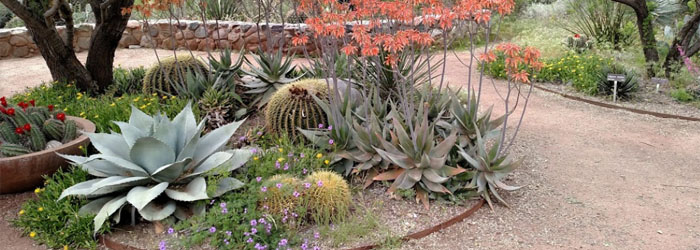
Top Gardens to Visit
In most of the United States, homeowners get ready to shut down their yards and gardens in September. But in much of Arizona as the weather cools, we're getting ready for our second spring – a time to plant, landscape and launch a new beginning for our yards.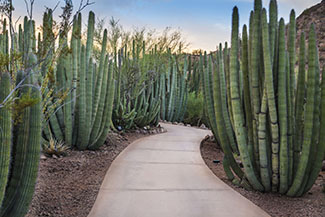
Before you start, we'd suggest visiting some inspiring garden spots and beautiful wild landscapes you can find all over the state. We've listed eight here, including some well-known spots and some that may be new to you. Even if you are not able to visit all of them, a couple might be all you need for inspiration to get you started.
Even if you've already landscaped your yard, these garden spots are great places to see unique desert and arid-adapted plants that can survive in a rugged environment:
1 | Desert Botanical Garden in Papago Park, Phoenix
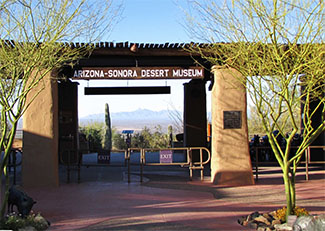
The garden, founded in 1939, is the best of them all and is one of the most magnificent sites in the state. DBG has five trails that focus on the drama and beauty of the Sonoran Desert, including one that suggests sustainable ways to garden at your home. There are 10s of thousands of plants here, including many varieties of cactus, agaves, aloes and other desert flora that might work in your yard. A visit can be vast and overwhelming, but will increase your love for desert plants. Visit the Desert Botanical Garden
2 | Arizona-Sonora Desert Museum
This other great site in the Tucson area was founded in 1952 and is located near Saguaro National Park. That means, you can make the park part of your trek as well. Much of the museum is devoted to desert animals, but there are also 16 individual desert botanical gardens with 1,200 plant species and 56,000 individual plants. Visit the Arizona-Sonora Desert Museum
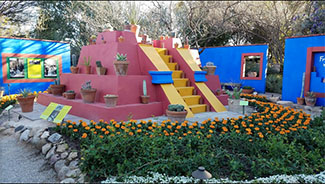
3 | Tucson Botanical Garden
In a more urban setting in Tucson, you'll find this garden that started out as the home of the Porter family in the 1920s. The family ran a nursery there from the 1920s to 1950s. Eventually, the property was donated to the city of Tucson and became a public garden. It's a 5.5-acre sanctuary featuring a cactus plus succulent garden, a barrio garden and an herb garden with tons of native plants. There's also a butterfly and orchid pavilion. Visit the Tucson Botanical Garden
4 | Scottsdale Xeriscape Garden
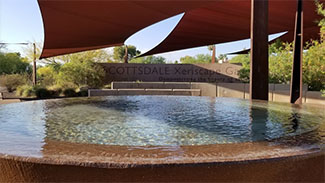 This garden in the city-run Chaparral Park features regionally appropriate plants planted to reduce outdoor water use and encourage residents to swing toward growing a sustainable landscape. The garden actually conceals a buried 5.5 million gallon reservoir from the adjacent Chaparral Water Treatment plant and showcases more than 7,000 plants. Signs along the way give visitors tips on low-water use plants and trees as well as water harvesting. Visit the Scottsdale Xeriscape Garden
This garden in the city-run Chaparral Park features regionally appropriate plants planted to reduce outdoor water use and encourage residents to swing toward growing a sustainable landscape. The garden actually conceals a buried 5.5 million gallon reservoir from the adjacent Chaparral Water Treatment plant and showcases more than 7,000 plants. Signs along the way give visitors tips on low-water use plants and trees as well as water harvesting. Visit the Scottsdale Xeriscape Garden
5 | Rio Salado Restoration Area/Audubon Center
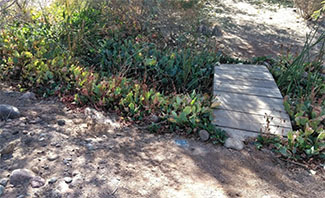
This area of paved and natural trails along the Salt River in the Phoenix area is especially popular with bird lovers since hundreds of species use the area as a migratory path. Although it's not exactly a garden spot, there's an Audubon Center on the property that can tell you everything about water issues in the desert. Visit the Rio Salado Habitat Restoration Area / Visit the Rio Salado Audubon Center
6 | Boyce Thompson Arboretum in Pinal County
This is the largest and oldest botanical garden in the state of Arizona. It's also one of the oldest botanical institutions west of the Mississippi. About one hour's drive east of Phoenix, it also makes a great day trip from Tucson. A couple of acres here are devoted to a demonstration garden complete with patios, walls, shade structures, water features and rock work. Signs guide homeowners through basic landscape design and plant choices. There is also info on water harvesting, building and maintaining a backyard "oasis" as well as advice on troubles home gardeners face with salinity in the desert. The arboretum is also a great place to buy plants – young versions of what you've seen on display. Visit the Boyce Thompson Arboretum
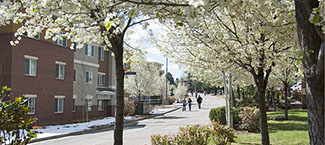
7 | Arizona College Campuses
The University of Arizona has a unique collection of plants from arid and semi-arid climates around the world. When the university began collecting special plants many years ago, date palms and olive trees as well as cactus were planted on the campus. Many campus trees are among the largest in Arizona and are on the National Register of Big Trees. In spring and fall, guided tours are given for many of the plant collections. Self-guided tours are also possibleusing brochures that the arboretum can give you. Visit the University of Arizona
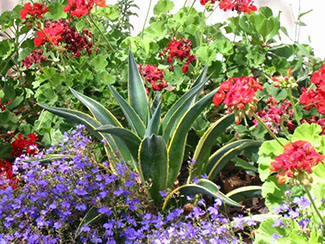 The entire Tempe campus at Arizona State University is dedicated as an arboretum. The Tempe campus landscape is a diverse collection of plants from around the world that includes citrus, olive, pecan, sapote, apple, peach, quince, sweet bay and many other harvestable trees and shrubs. They even have an Herb Garden. The ASU Arboretum collection is registered with the North American Plant Collections Consortium (NAPCC) and the American Association of Botanic Gardens and Arboretum (AABGA). Visit the Arboretum at ASU Tempe Campus
The entire Tempe campus at Arizona State University is dedicated as an arboretum. The Tempe campus landscape is a diverse collection of plants from around the world that includes citrus, olive, pecan, sapote, apple, peach, quince, sweet bay and many other harvestable trees and shrubs. They even have an Herb Garden. The ASU Arboretum collection is registered with the North American Plant Collections Consortium (NAPCC) and the American Association of Botanic Gardens and Arboretum (AABGA). Visit the Arboretum at ASU Tempe Campus
Another hidden treasure is Secret Garden at Arizona State University. This is a quiet tropical garden hidden away at the Dixie Gammage Courtyard. It's a botanical retreat meant for ASU students to relax in between classes.You could also reserve the Secret Garden if you wish. Visit the Secret Garden at Arizona State University
You can also take tours among distinctive trees on the campus of Northern Arizona University in Flagstaff. Learn about spruce, firs, aspens, cottonwoods, pines, junipers and more by visiting the arboretum. Visit Northern Arizona University
8 | The Arboretum at Flagstaff
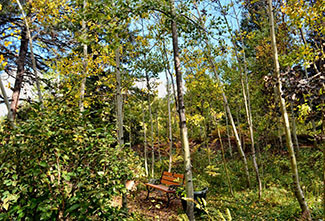
This 200-acre arboretum is home to 750 species of mostly drought-tolerant adapted and native plants representative of the high-desert Colorado Plateau, home to the Grand Canyon and Zion National Park. Visit the Arboretum at Flagstaff
Now that you've traveled to a few of these places and know what you want to plant in your yard, where do you go to make your dream landscape a reality? Some of the places listed in this article sell plants as well as well as educate the public and display them. Feel free to ask about acquiring plants of your own and how to care for them during your visits. You can also find local garden and nursery centers and answers to your gardening and landscape questions with the help of these resources:
- Plant Something
- Water Use It Wisely
- Arizona Department of Water Resources
- AMWUA - One For Water
- 602-827-8201 | The Maricopa and Cooperative Extension Offices - Call and ask the Master Gardeners questions!
bonus locations & Scenic drive suggestions
If you are looking for a few more places to explore, these may peak your interest as well:
Carefree Desert Garden & Sundial
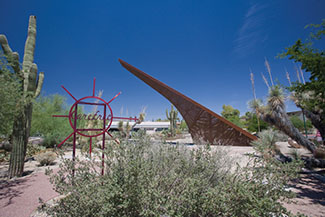 The famous giant sundial has been attracting people to Carefree since 1959. At the time the sundial was built is was the second largest working sundial in the western hemisphere. Not only is this a neat piece of history, but it is also surrounded with plant life thanks to a local landscape company who has donated and installed over 2,000 plants since 2012 centered around this large sundial. Visit the Carefree Desert Garden and Sundial
The famous giant sundial has been attracting people to Carefree since 1959. At the time the sundial was built is was the second largest working sundial in the western hemisphere. Not only is this a neat piece of history, but it is also surrounded with plant life thanks to a local landscape company who has donated and installed over 2,000 plants since 2012 centered around this large sundial. Visit the Carefree Desert Garden and Sundial
If you want more inspiration and have the time to travel the backroads to scenic spots throughout Arizona, consider some wilder landscapes:
- Apache Trail 88 to Roosevelt Dam
- The drive from Cave Creek to Bartlett Lake
- Florence to Oracle Junction on 79 and back up to Superior on 77
- Gila Bend to Tucson via Highways 85 and 86 with a swing through Organ Pipe National Monument
- The Verde River - multiple hiking opportunities and river access points
- Oak Creek Canyon, San Pedro River, & Aravaipa Canyon
- Old Nogales Highway through the pecan groves not too far from Tucson
- Marsh Station Rd. neat desert riparian habitat and setting with old railroad bridge not far from tucson
- Desert exhibition garden in Mesa at Brinton Botanical Garden with old hohokam canal
- Rose Garden at Mesa Community College
- Valley Garden Center at Encanto Park
- Japanese Friendship Garden
- Old Gillespie Dam and Bridge on the Gila south of Arlington
- Drive between Nogales and Patagonia on 82
- The drive to bartlett has lots of poppies even after the burn if we get enough rain
###
Photo Credits:
- Desert Botanical Garden
- Boyce Thompson Arboretum
- Arizona-Sonora Desert Museum
- Tucson Botanical Garden
- Scottsdale Xeriscape Garden
- Rio Salado Audubon Center
- NAU Arboretum
- Secret Garden at ASU
RELATED CONTENT:
- Blog: All About Saguaros
- Blog: Plants: Out Of Control
- Blog: Beneficial Bugs We May Want In Our Yard
- KTAR Blog: Five Low-Water Trees To Provide Shade For Your Arizona Home
- DIY FAQ: Tips For Setting Up Your Drip Irrigation System
- Podcast: Plants That Love Arizona Too Much
Print this page
recent post
- Duck, Duck, Duct! How Often Should Ductwork Be Cleaned?
- Vinyl vs. Fiberglass Windows: Which Is The Better Choice Of Replacement Window?
- We May Be The Grand Canyon State, But The Rocky Mountains Are Important For Arizona
- Welcome to Arizona! Things A Newbie to Arizona Should Know
- The Pros & Cons of Buying A Flipped House
- Getting In On The Ground Floor
- Why It’s More Critical Than Ever To Get Your AC Serviced Before Summer
- The Reality of Remodeling
- What To Look For When Comparing Your Roofing Quotes
- What To Expect When Buying New Windows & Doors
